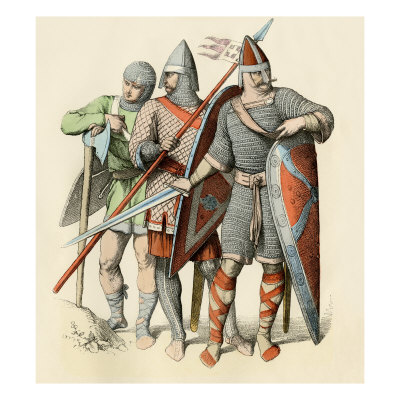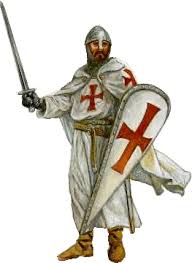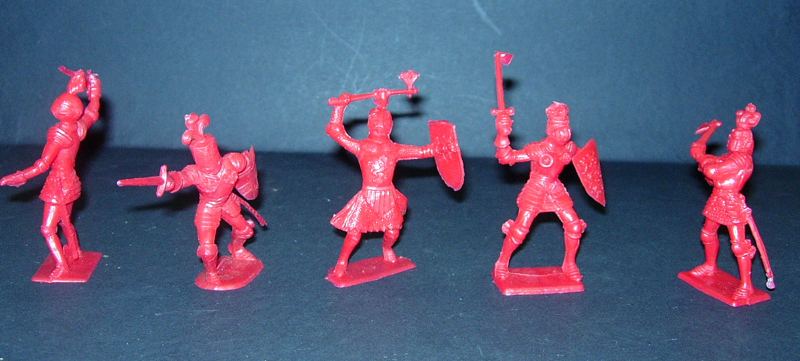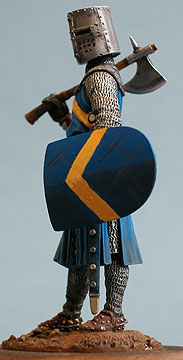 he most useful website that I found appeared to be a personal work that discussed some influences in the development of metal armor. Then I turned to bound literary works for more precise information. Five such sources proved useful to me.below 1066
he most useful website that I found appeared to be a personal work that discussed some influences in the development of metal armor. Then I turned to bound literary works for more precise information. Five such sources proved useful to me.below 1066
The first source I will discuss here is a large folio entitled Medieval Warfare by H.W. Koch. This book discusses details on the weapons, armor, and battles of medieval times . From what I had read, Koch writes rather eloquently, but the topics do not suit the subject of this paper. Instead I examined the artwork 1156 below
. From what I had read, Koch writes rather eloquently, but the topics do not suit the subject of this paper. Instead I examined the artwork 1156 below reproduced in the folio. The paintings provided primary source information about the armor that existed and how it was used during the
reproduced in the folio. The paintings provided primary source information about the armor that existed and how it was used during the  Middle Ages. Using paintings to study technology does have its risks though.
Middle Ages. Using paintings to study technology does have its risks though.
 Unlike photographs, paintings are subject to the interpretations of the painter and the painter is not always accurate. In a large number of medieval works the painter never intends to be accurate.
Unlike photographs, paintings are subject to the interpretations of the painter and the painter is not always accurate. In a large number of medieval works the painter never intends to be accurate.  Such inaccuracies are especially evident in fifteenth century portrayals of ancient heroes such as Alexander the Great and his soldiers donning full chain mail and plate armor.
Such inaccuracies are especially evident in fifteenth century portrayals of ancient heroes such as Alexander the Great and his soldiers donning full chain mail and plate armor.
 reproduced in the folio. The paintings provided primary source information about the armor that existed and how it was used during the
reproduced in the folio. The paintings provided primary source information about the armor that existed and how it was used during the  Middle Ages. Using paintings to study technology does have its risks though.
Middle Ages. Using paintings to study technology does have its risks though.
 Unlike photographs, paintings are subject to the interpretations of the painter and the painter is not always accurate. In a large number of medieval works the painter never intends to be accurate.
Unlike photographs, paintings are subject to the interpretations of the painter and the painter is not always accurate. In a large number of medieval works the painter never intends to be accurate.  Such inaccuracies are especially evident in fifteenth century portrayals of ancient heroes such as Alexander the Great and his soldiers donning full chain mail and plate armor.
Such inaccuracies are especially evident in fifteenth century portrayals of ancient heroes such as Alexander the Great and his soldiers donning full chain mail and plate armor.Another source that I looked at was Richard Barber's The Knight and Chivalry. In this book Barber restates  many of the older beliefs about medieval armor that are now contested by modern historians.
many of the older beliefs about medieval armor that are now contested by modern historians. In some parts his technological determinist views proclaim how certain technologies caused armor to appear or how the
In some parts his technological determinist views proclaim how certain technologies caused armor to appear or how the appearance of new armor led to new technologies, such as in his statement,
appearance of new armor led to new technologies, such as in his statement,  "The knight's role in the actual fighting was strongly influenced by the development of armour." (Barber 193) Barber's main argument about armor seems to be that medieval armor was ineffective in combat and ultimately failed because it restricted mobility too much without enough gain in protection.
"The knight's role in the actual fighting was strongly influenced by the development of armour." (Barber 193) Barber's main argument about armor seems to be that medieval armor was ineffective in combat and ultimately failed because it restricted mobility too much without enough gain in protection. I disagree with many of Barber's statements in favor of the arguments presented in the other sources.Gerhard Jaritz presents views opposite to Barber's on his Internet website.
I disagree with many of Barber's statements in favor of the arguments presented in the other sources.Gerhard Jaritz presents views opposite to Barber's on his Internet website. Jaritz states that "Modern reconstructions have shown that fighters in full suits of mail or plate can perform cartwheels, leap up directly from the ground, and even sprint for short distances." (Jaritz http://www.ceu.hu/medstud/manual/SRM/armor.htm) Furthermore, he argues that medieval armor was extremely effective and rendered armored warriors almost invincible. The contradicting views of these two authors presents another problem in the study of medieval armor. There is really no way to tell how effective armor was in battle unless it is actually tested in a real battle situation. All we can do is examine the evidence we have and make informed speculations based on our findings.
Jaritz states that "Modern reconstructions have shown that fighters in full suits of mail or plate can perform cartwheels, leap up directly from the ground, and even sprint for short distances." (Jaritz http://www.ceu.hu/medstud/manual/SRM/armor.htm) Furthermore, he argues that medieval armor was extremely effective and rendered armored warriors almost invincible. The contradicting views of these two authors presents another problem in the study of medieval armor. There is really no way to tell how effective armor was in battle unless it is actually tested in a real battle situation. All we can do is examine the evidence we have and make informed speculations based on our findings.
 many of the older beliefs about medieval armor that are now contested by modern historians.
many of the older beliefs about medieval armor that are now contested by modern historians. In some parts his technological determinist views proclaim how certain technologies caused armor to appear or how the
In some parts his technological determinist views proclaim how certain technologies caused armor to appear or how the appearance of new armor led to new technologies, such as in his statement,
appearance of new armor led to new technologies, such as in his statement,  "The knight's role in the actual fighting was strongly influenced by the development of armour." (Barber 193) Barber's main argument about armor seems to be that medieval armor was ineffective in combat and ultimately failed because it restricted mobility too much without enough gain in protection.
"The knight's role in the actual fighting was strongly influenced by the development of armour." (Barber 193) Barber's main argument about armor seems to be that medieval armor was ineffective in combat and ultimately failed because it restricted mobility too much without enough gain in protection. I disagree with many of Barber's statements in favor of the arguments presented in the other sources.Gerhard Jaritz presents views opposite to Barber's on his Internet website.
I disagree with many of Barber's statements in favor of the arguments presented in the other sources.Gerhard Jaritz presents views opposite to Barber's on his Internet website. Jaritz states that "Modern reconstructions have shown that fighters in full suits of mail or plate can perform cartwheels, leap up directly from the ground, and even sprint for short distances." (Jaritz http://www.ceu.hu/medstud/manual/SRM/armor.htm) Furthermore, he argues that medieval armor was extremely effective and rendered armored warriors almost invincible. The contradicting views of these two authors presents another problem in the study of medieval armor. There is really no way to tell how effective armor was in battle unless it is actually tested in a real battle situation. All we can do is examine the evidence we have and make informed speculations based on our findings.
Jaritz states that "Modern reconstructions have shown that fighters in full suits of mail or plate can perform cartwheels, leap up directly from the ground, and even sprint for short distances." (Jaritz http://www.ceu.hu/medstud/manual/SRM/armor.htm) Furthermore, he argues that medieval armor was extremely effective and rendered armored warriors almost invincible. The contradicting views of these two authors presents another problem in the study of medieval armor. There is really no way to tell how effective armor was in battle unless it is actually tested in a real battle situation. All we can do is examine the evidence we have and make informed speculations based on our findings.
The remaining three sources I have examined are less extreme in their arguments, but offer a wealth of seemingly objective information. Particularly interesting is Stephen Turnbull's Book of the Medieval Knight, which details many of the causes, effects, and consequences of new advances in armor. Turnbull does a great job in describing the development of armor in terms of actor/network theory by outlining specific events and problems that forced changes in existing armor designs. Change might not have occurred so quickly as suggested by Turnbull, but his argument is presented thoughtfully and convincingly.
effects, and consequences of new advances in armor. Turnbull does a great job in describing the development of armor in terms of actor/network theory by outlining specific events and problems that forced changes in existing armor designs. Change might not have occurred so quickly as suggested by Turnbull, but his argument is presented thoughtfully and convincingly.
 effects, and consequences of new advances in armor. Turnbull does a great job in describing the development of armor in terms of actor/network theory by outlining specific events and problems that forced changes in existing armor designs. Change might not have occurred so quickly as suggested by Turnbull, but his argument is presented thoughtfully and convincingly.
effects, and consequences of new advances in armor. Turnbull does a great job in describing the development of armor in terms of actor/network theory by outlining specific events and problems that forced changes in existing armor designs. Change might not have occurred so quickly as suggested by Turnbull, but his argument is presented thoughtfully and convincingly.
Another book, The Shield and the Sword by Ernle Bradford is not extremely interesting, but one comment did stand out. Bradford acknowledges that it took tremendous amounts of training and endurance for a medieval knight to effectively wear heavy armor and use weapons in combat, such that modern men cannot perceive how medieval arms could ever have been used effectively. He quotes, "It is one of the mysteries in the history of armour how the crusaders can have fought under the scorching sun of the East in thick quilted garments covered with excessively heavy chain mail." (Bradford 40) What was effective in the middle ages may not be effective in modern times, so one cannot argue that medieval arms were ineffective and failed. Any technology that endured and evolved over several hundred years as metal armor did must have been useful. Medieval armor had lived up to its main purpose of saving lives.
The final source that I looked at was The Medieval Machine by Jean Gimpel. The focus of the book is not on medieval knights and warfare, but it focuses on medieval invention. Because of this, it offers a different perspective on the development of armor. Armor was only briefly mentioned, but Gimpel discussed medieval iron production in detail. According to Gimpel, armor production during the middle ages was much higher than I had anticipated, facilitating the ability to equip entire armies with metal armor. Though heavy armor was exclusively used among the wealthy, some rulers were wealthy enough to amass fairly large armies of heavy calvary.
The main trend that I noticed among all of my sources was that older books tended to argue that armor was very slow and ineffective, whereas modern sources tended to claim that armor was crafted well enough that it was fairly light, easy to maneuver in, and highly effective.
 I believe that it was more of the latter, or else plate armor would never have evolved into the glorious heavy suits that we all know from legend.Chain mail armor was used very extensively throughout the medieval times.
I believe that it was more of the latter, or else plate armor would never have evolved into the glorious heavy suits that we all know from legend.Chain mail armor was used very extensively throughout the medieval times. It consisted of thousands of riveted iron rings to form a mesh. The chain mesh was then crafted into relatively light protective garments such as shirts or leggings. A chain mail shirt was called a hauberk or byrnie, while mail leggings for the lower legs and feet were called the chausses. Hauberks and chausses were made at varying lengths depending on how much weight the warrior could carry for protection. Usually heavy padding was worn underneath chain mail armor to prevent painful chafing and absorb the shock of blows taken in battle. This padding was called the gambeson or aketon. Gambesons were simply tunics packed with wool and were used early in the Middle Ages. The aketons worn later on were padded garments that were lighter than gambesons.Go to the brilliant Knights of Avalon site.
It consisted of thousands of riveted iron rings to form a mesh. The chain mesh was then crafted into relatively light protective garments such as shirts or leggings. A chain mail shirt was called a hauberk or byrnie, while mail leggings for the lower legs and feet were called the chausses. Hauberks and chausses were made at varying lengths depending on how much weight the warrior could carry for protection. Usually heavy padding was worn underneath chain mail armor to prevent painful chafing and absorb the shock of blows taken in battle. This padding was called the gambeson or aketon. Gambesons were simply tunics packed with wool and were used early in the Middle Ages. The aketons worn later on were padded garments that were lighter than gambesons.Go to the brilliant Knights of Avalon site.  Here is the introduction
Here is the introductionWelcome to Knights of Avalon
I started Knights of Avalon in 1999 at that time my reference books on lead figures were well use, but many times I found them lacking, the photographs were sometimes poor quality often too small and mostly in black and white. My main interest was Timpo Round Table Knights and their correct naming, but the site took on a life of its own and grew. It now has hundreds of pages and gets about 600 visitors a day . I add to this site constantly, all area get new pictures when they become available, often thought fellow collectors generously sending me pictures from their collections.The site now also contains hundreds of pictures of toy,cowboys,Indians, and many lead figures from British makers from the 50’s alongside the knights.Thank you for visiting...
No comments:
Post a Comment